Berlin International Film Festival
The 73rd Berlin Film Festival took place from Feb. 16 to 26 this year. Since 2020 the festival is led by artistic director Carlo Chatrian, (Italian film critic and festival director) and managing director Mariette Rissenbeek (Dutch film producer and marketing manager). 2023 the jury president is US actress Kristen Stewart, and there are 19 films in competition.
The Berlin Competition 2023
The competition, “the centrepiece of the Berlinale and the festival’s calling card,” is described rather ambitiously on the website berlinale.de:
(the competition) provides a detailed picture of the cinema as it is and as it will be. Whether from established or up-and-coming directors, films in the Competition present the best of the year’s selection.
As the festival’s centre of gravity, the Competition concentrates the energy of the Berlinale and catches the world’s attention. It is the focal point of the festival and screens some of the year’s most talked-about films, frequently prompting heated debates. Embracing the diversity of cinema and its extensive production in the 21st century, the Competition aims to surprise, entertain and enrich public audiences and industry professionals alike. It reflects and relates to the world in which we are living: its selection allows viewers to understand their place in it more fully and to recognise and respect the place of others.
This year, Carlo Chatrian, supported by a selection committee, has chosen 19 films for the competition, including the documentary SUR L’ADAMANT / ON THE ADAMANT (directed by Nicolas Philibert) and two animated films, ART COLLEGE 1994 (directed by Liu Jian) and すずめの戸締まり / SUZUME (directed by Makoto Shinkai).
6-Departments-Check 2023
The first image shows the 6-departments-check for the 19 competition films, i.e. the share of women and men for the departments of direction, screenplay, camera, sound, editing and music. The data for sound (16 films) and music (14 films) are still incomplete, since not all positions could be determined via official sources. At this point, many thanks to Mayho Ho, who researched the gender of some team members of the two Chinese films for me. Dankeschön!
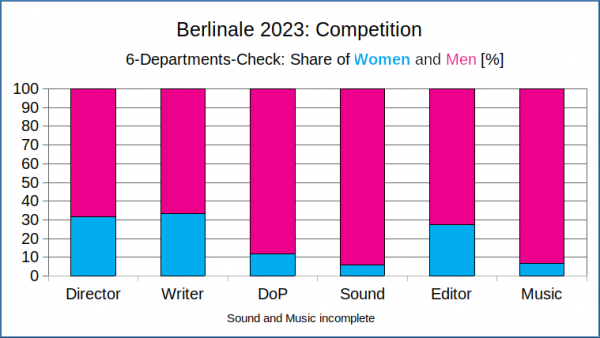
The proportion of female directors and writers is just under one third. The equality of the values is also due to the fact that 15 directors wrote the scripts alone and 4 others wrote them as part of a team. This is still far from the 50% threshhold that has been called for for years, and not only for films by female directors. Female editors make up less than 30%, which is probably well below the proportion of women in this profession internationally. The share for women cinematographers is less than 12%, and that of women sound mixers and composers is even less than 7%.
Ages of the directors
The second figure shows the age range of the nineteen directors, divided into 5-year groups according to year of birth:
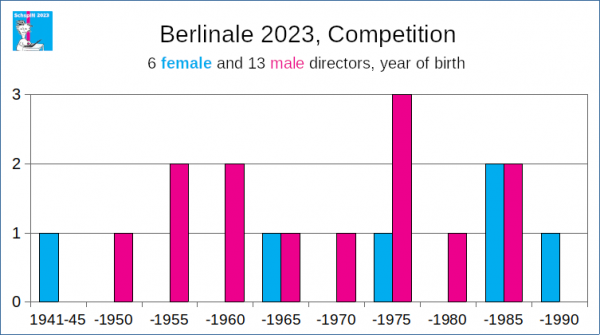
The oldest is Margarethe von Trotta, director and writer of INGEBORG BACHMANN – REISE IN DIE WÜSTE / JOURNEY INTO THE DESERT. Surprisingly, this is only the second time she has been invited to the Berlinale Competition, the first time was with HELLER WAHN / A LABOUR OF LOVE at the 1983 Berlinale. DAS VERSPRECHEN / THE PROMISE ran out of competition in the 1995 Competition.
Then we have five male directors born between 1948 and 1960; no female director from this age segment was invited. The second oldest director in the Competition is Angela Schanelec (born 1962), represented by the Oedipal drama MUSIC. The youngest is the Korean-Canadian Celine Song, in her early 30s, who is presenting her directorial debut with PAST LIVES.
The ages of the leading actors
A few days ago, the Let’s Change the Picture campaign initiated by German online magazine Palais F*luxx went public. The campaign is about the (in)visibility of women over 47 on German screens. That’s why I’d like to take a look at the age of the first-named roles in the 18 competition films. For the animated films I have taken the age of the dubbing actors. The age of Mwajemi Hussein, who played the role of BlackWoman in THE SURVIVAL OF KINDNESS, is estimated; I have not found any information on her.
No actress reaches the 47-year threshold. Three actors are above it, the oldest being Australian Simon Baker (53) in the mystery-crime film LIMBO (directed, written, cinematographed, edited, music: Ivan Sen). The oldest leading actress is 46-year-old Anabela Moreira in the Portuguese drama MAL VIVER (director and screenwriter: Joao Canijo). It is striking that almost half of the directors in the Competition, namely eight, are older than Simon Baker. Or vice versa: most of the authors do not write stories about or around someone their own age, but about characters who are sometimes much younger.
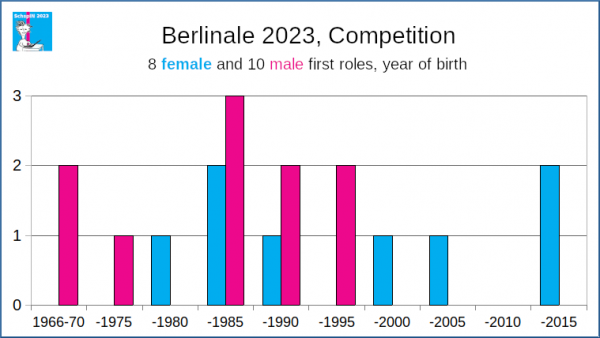
As an example, let’s take Christian Petzold‘s male-heavy relationship drama RED HEAVEN / AFIRE, which is set in his children’s generation. The main cast consists of four actors (25, 28, 29 and 61 years old) and one actress (27), and according to the Berlinale website the story is “about not being able to sleep and wanting to love, about writing and being read, about being in the world and yet possibly living past it. A film suspended between symbolism and realism, comic and deeply tragic.” Uh-huh. In a way, Petzold (62) is fuelling criticism by Let’s Change the Picture with his work. While he had shot mainly with the now 47-year-old Nina Hoss from 2002-14, since 2018 the 1995-born Paula Beer has been the favourite for his female lead characters. According to an interview for thefilmstage.com, RED HEAVEN was about (physical) love among young people. But that is still happening in his generation as well, isn’t it?
The pathos of RED HEAVEN – “As the (publisher) turns the corner in the dashing compact car, the forest begins to blaze. Ashes rain down, the sky turns red and the relationship drama, which combines physical intensity and artistic sublimation, takes a turn into a new dimension.” forms the bridge to another German competition entry IRGENDWANN WERDEN WIR UNS ALLES ERZÄHLEN / SOMEDAY WE’LL TELL EACH OTHER EVERYTHING, directed by Emily Atef: “This film tells of charisma, of naked bodies, of lack of will and longing. Pure, direct, open. Unimagined German romance.“
Perhaps a connection can somehow be made to the festival competition’s claim “It reflects and relates to the world we live in: the films enable viewers to better understand their own place in the world and to respect other people’s point of view.” – but since I haven’t seen the films I can’t say much about it.
Four competition entries tell family stories with three generations:
- 20.000 ESPECIES DE ABEJAS / 20,000 SPECIES OF BEES by Estibaliz Urresola Solaguren.
LE GRAND CHARIOT / THE PLOUGH by Philipp Garrel.
MAL VIVER / BAD LIVING by João Canijo.
TÓTEM by Lila Avilés.
The first and last of these titles feature the two youngest of the first-named actors, Sofia Otero (8) and Naima Senties (7).
With reservations, because I don’t know any of the films from watching them: I notice that burning issues such as climate change, Russia’s aggressive war against Ukraine, femicide, the uprising in Iran, the fates of millions of refugees, the last African colony Western Sahara, growing right-wing populism, the consequences of Brexit, housing shortages, covid, privileged mobility, child labour, forced prostitution, increasing anti-Semitism, conspiracy myths, surveillance societies – to name but a few – leave no trace in the 2023 Competition. But perhaps they will appear in other sections of the festival. John Trengove‘s competition entry MANODROME deals with toxic masculinity. And perhaps the forest fires in Petzold‘s film are due to global warming?
The first four years of the new Berlinale management
On the sidelines of his last Berlinale as festival director, at the Berlinale Event of Women in Film and Television Germany in February 2019, Dieter Kosslick signed the 50/50 by 2020 Pledge, i.e. a commitment to 50:50 gender parity, as the third A-list festival after Cannes and Venice. That year, the proportion of female directors in the Berlinale competition was 43.8%. Speaking to Deutschlandfunk, Kosslick said: “(My successors) see it like I do, otherwise I can’t sign that. (…) I have already agreed this with them.” Does the voluntary commitment have an effect on the competition?
The next figure shows the proportions of women and men in the direction of the competition films of the Chatrian / Rissenbeek era:
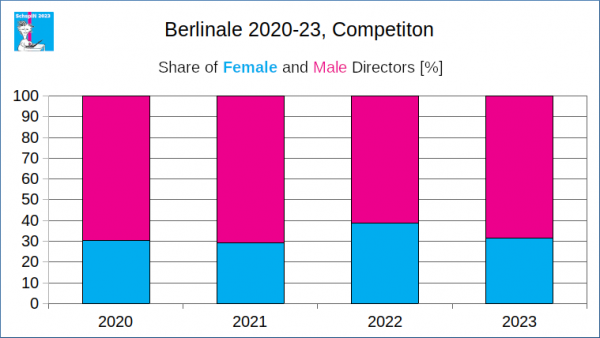
The female directors reach around 30 %, the highest value of 31.6 % this year is still less than a third, more than 10 percentage points below the 2019 value. For the 2020 Competition, the Berlinale has calculated a higher value – which I cannot reproduce – (33%). I will briefly go into this at the end of this text.
“The established auteur cinema from all over the world”.
What about the countries of origin of the films? Is the whole world really represented here? Let’s take a look at all the production and co-production countries mentioned in the Competition lists on the Berlinale website, grouped by continent. The Central American and Caribbean countries are counted as North America. All figures refer to the number of countries per continent, not to the number of films:
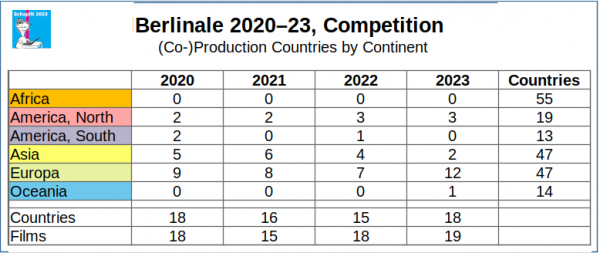
No film (co-)produced by an African country made it into the competition. And that is not the only gap. The following table shows the directors’ countries of origin, which confirms the trend: 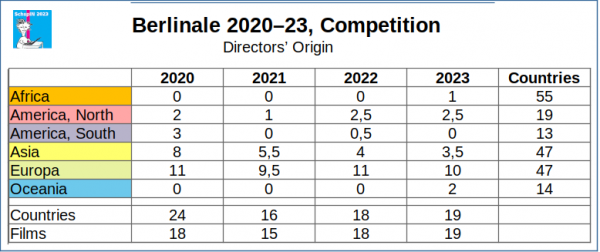
To be able to classify the figures more clearly, here are the tables for the individual countries, again for production and direction. Not a single film from India. The Indian film industry produces 250 films a year. None are good enough for the Berlinale?
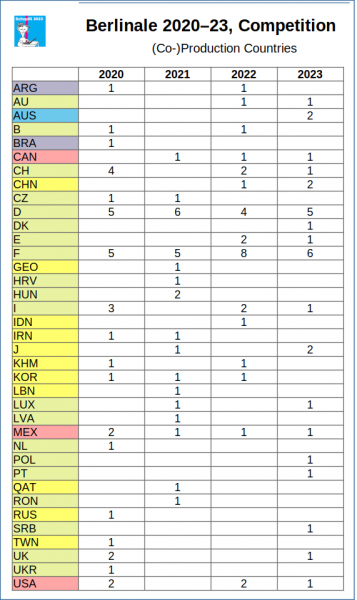
Only three times was a director invited from Korea (i.e. South Korea). And it was always the same one, Hong Sangsoo. He has now been nominated six times for a Golden Bear, i.e. in the Competition, and Chatrian has invited him three times in four years alone. Are there any other filmmakers from South Korea who could be considered? Like Hong Sangsoo, Christian Petzold, who is participating for the fourth time this year, is also a Competition nominee. Are their films always of such a high standard that there is no way around them? And there is no room for the films of Sabu, for example? Or the films of directors from Central or South America? There are no films from Eastern Europe in the competition in 2023 either.
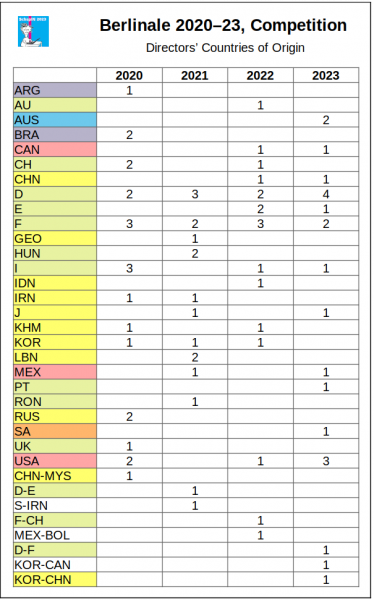
Sexiest Man Living in the USA
I imagine the work of the selection committee is anything but easy. But it does sound a bit like “the usual directors” and “the usual countries”. One is tempted to think of the unspeakable “Sexiest Man Alive” award. The previous winners reinforce the suspicion that it is only about the “Sexiest Man from the USA”, whether he was born there or works there – preferably in the film industry:

That is the so-called tunnel vision. And it might prevent a film from India, Africa or South America from being in the competition at the Berlinale. Which is perhaps simply different from what our viewing habits perceive as good – and could be an enrichment.
I have already mentioned Hong Sangsoo (3) and Christian Petzold (2) as frequent guests in the 2020-23 Competition. Apart from them, only Philippe Garrel (2) and Rithy Panh (2) have been there more than once under the current direction. And of those who have been in the 2020-23 competition, only Andreas Dresen (4 times since 1999) Denis Coté (4 times since 2013), Francois Ozon (6 times since 2000) Lu Zhang (4 times since 2005) come to more than 3 participations in total. Only men. Do women take longer to produce – perhaps because they have more difficulty financing their projects – and therefore come up with fewer potential invitations? Or are they simply overlooked, passed over? That’s a topic for another day.
If you are going to the Berlinale: have fun, stay healthy, and hopefully see lots of inspiring films. If you don’t go: I’m keeping my fingers crossed for all of us that many films – especially those not in German or English – will be shown in our cinemas after all.

One Comment
Leave a reply →